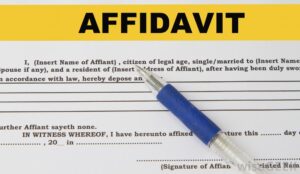An “Affidavit of Death” is a legal document that confirms the deceased person’s identity as the owner of the property and subtly strikes their name from the title. The affidavit of death is usually submitted following the death of the property owner and before processing any other paperwork that may impact the title to the property. When filing, a certified copy of the death certificate is required. Continue reading to learn more.
An Affidavit of Death: What Is It?
A sworn declaration of death is called an affidavit of death. Notifying companies, authorities, and courts of a deceased person’s passing is only one of the administrative duties that this legal document can assist you with handling following their death.
For instance, you could have to pay off an outstanding credit card bill or auto loan payment, or you might need to inform your late spouse’s life insurance company of their passing. This affidavit is frequently required to terminate accounts or obtain benefits, along with a death certificate.
When Is a Death Affidavit Required?
It is necessary to take care of a deceased person’s estate and legal matters. For several situations requiring the effective transfer and distribution of property, people require an affidavit of death, such as:
- To provide the legal framework allowing the heirs or beneficiaries to inherit the legally deceased person’s assets and property.
- To move or close a deceased person’s investment accounts, bank accounts, or other financial holdings.
- Should stop the benefits and notify the appropriate government agencies.
- Initiate the procedure for submitting an insurance claim.
- To complete other assignments in which the departed has a claim, debt, or interest.
- A death affidavit is for everyone’s security. By requiring one, fraud in a court or business is less likely.
- Additionally, it expedites the distribution and transfer of property, making it easier to wind up one’s estate and legal matters.
Things to put in:
The following are necessary components of affidavits of death:
- The location of the affidavit’s signature is the state and county.
- Affiant: The signer’s full legal name and address are on file with the court.
- The affiant’s capacity legally: a declaration of the signer’s legal age.
- Decedent: The deceased person’s complete legal name and identity.
- Date of death of the decedent: the date of the decedent’s birth and death.
- Under penalty of perjury, an affirmation certifies that the signer considers the information in the affidavit to be truthful and correct.
- A notary public is required to witness and sign the affidavit.
Affidavits of Death: Types
Affidavits of death are most frequently used when a decedent is passing property to their heirs in a variety of ways.
Co-tenancy:
When to use it:
If the departed owner of the property had joint tenancy.
In a joint tenancy, both spouses share common property ownership, with one becoming the only heir upon the other’s passing. If you want to transfer property without the approval of every title holder, you must have an Affidavit of Death.
Trustees:
When to use:
Should a living trust have a title that belongs to the dead landowner?
When a married couple creates a living trust, if one spouse passes away, the assets transfer to the surviving trustor. In the absence of a co-trustor, the assets transfer to a successor trustee, who, upon the trustee’s passing, distributes them to the named beneficiaries.
Spouse’s Death:
When to use:
When a spouse passes away, their surviving spouse can use an Affidavit of Death to have their name removed from joint bank accounts, money market accounts, credit cards, and other accounts where the deceased spouse had title as Community Property with the Right of Survivorship.
Except for a will or transfer on death instruction that leaves the account’s contents to someone else, this document also authorizes the transfer of money from an account that the deceased solely owned to a legitimate spouse.
A couple’s property is equally theirs if the state follows community property laws.
The Affidavit of Death of Spouse implicitly transfers ownership of all communal property to the surviving spouse in states where survivorship laws are in effect. An affidavit of spousal death also serves as documentation of a survivor’s eligibility for pension or 401(k) benefits.
Death of Grantor:
When to use it:
If the decedent filed a transfer on death or beneficiary deed,.
With the use of an affidavit of death from the grantor, account holders can choose someone to receive their money following their death in some states that have “transfer on death” provisions.
Death Intestinal:
When to use it:
If the decedent dies without leaving a will or precise instructions for the distribution of their estate.
Laws about intestacy prescribe the division of property among relatives. If an individual passes away, their belongings pass to their parents, siblings, and, if both are still living, to the lone surviving parent. Property transfers are permissible with an affidavit of death intestate.



